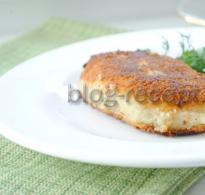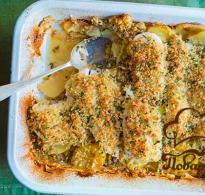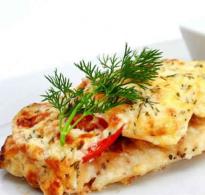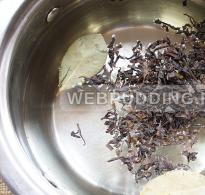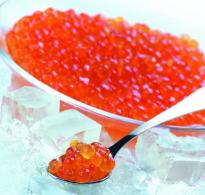What is the name of the cake spoon? How to distinguish a dessert fork from others? Cupronickel cutlery
As you can easily guess from the name, a dessert fork is designed to be used to eat desserts. This device is not necessary for daily use; at home you can completely do without it, using a spoon or even your hands. But if you are going to attend a special event where dessert will be served among other dishes, you should learn how to use this cutlery.
A dessert fork is needed in order to avoid unpleasant embarrassment with dripping fruit juice, crumbling crumbs and cream falling off the cake. as it is much more widespread, but there are a number of dishes that need to be eaten with a fork.
How to distinguish a dessert fork from others?
If you are afraid of getting confused in a restaurant, prepare for the event in advance. During long, multi-element meals, your table may end up with several forks. There are four main varieties. Don't worry, they are different, they can be easily distinguished from each other.

- The table fork has a traditional shape, small or medium deflection, large dimensions and 4 teeth. It is intended for main dishes and is used in company with a knife.
- A fish fork is smaller and narrower, with 3 or 4 prongs. This device can be paired or used together with a fish knife. It depends on the type of fish and the format of the event. Some dishes are more convenient to eat with two forks.
- The salad bowl looks like a small spoon with teeth. It has a curved shape, making it convenient to scoop up salad.
- Well, the dessert fork will be served to you when dessert appears on the table or large fruit which needs to be cut into pieces. Most of these forks have 3 prongs, but there are also products with two or four.
The dessert fork, the photo of which you see in this article, can be used for most desserts.
Buffet fork for baking
At some events that take place in a buffet format, they also serve some unusual utensils. They are a type of dessert fork, the rightmost tine of which is sharpened and elongated. This is done so that you can cut pieces of a pie or cake while holding a saucer in your hands. After all, it is impossible to use a knife in such a situation. Remember: this device can only be used when the plate is not on the table. If you can sit down and put it down, take a knife.

Fruit fork
Another common type of dessert fork is equipped with only two tines. They are quite sharp. This fork is designed for fruits and berries. They don’t eat cakes and cakes with it. If a classic dessert fork with three prongs can be served at a table where there are both fruits and pastries, then a two-pronged berry fork acts as an additional device. She does not play solo parts at feasts with many dishes.

Serving rules
This device is placed behind the plate, towards the center of the table. They put her behind her dessert spoon. The fork handle is always directed to the left. The dessert knife can be placed between the fork and the plate or on the dessert saucer, to the left of the main plate.

It is acceptable to hold a fork in your right hand, but the vast majority of dishes for which it is intended cannot be eaten carefully without a knife. Therefore, when you use both utensils, hold them the same way as cutlery: the knife in your right hand and the fork in your left. An exception may be a soufflé, a cocktail salad from small pieces fruits and cream, desserts from soft cheese in ice cream bowls. For these airy ones, delicate dishes Can be used independently as a dessert fork. You already know where this device is located and how to recognize it among other plugs. All that remains is to remember what dishes are eaten with it.
What do you eat with a dessert fork?
Sponge cakes, puff pastries, shortbreads and cakes crumble very much, so you should not bite off the delicacy. Cut off a little with a knife and eat with a fork. When serving, watermelons, pineapples and melons are cut into large pieces in portioned pieces, put one on a plate. Slices are cut from the piece, also one at a time. Remove the watermelon seeds on a plate using a fork and knife. The dessert fork should be in your left hand, don’t forget this. Do the same with grapes. The berries need to be cut in half, the seeds removed, and the halves placed on a fork. Small boneless berries are not eaten with a fork.

Informal atmosphere
It is not always necessary to observe strict ceremony. For example, if you are going on a picnic with close friends or family members, and pies and watermelons will be served, dessert forks, spoons and knives may not be used. It is acceptable to eat a treat by holding it in your hand and biting it off. small pieces. In this case, you should not cut the treats too large so that they are comfortable to hold in your hand.
“But I can’t fish, I’m allergic to it.” Remember how in the film “Moscow Doesn’t Believe in Tears” the heroine was frightened by the sight of proper table setting? And it’s not surprising to get confused, especially for a person ignorant of such matters, where the abundance of cutlery really drives you into a dead end, but at least a fish fork. Who knows what it looks like, and in general which forks from the complete set are intended for seafood? This is what our article will be about today.
In general, cinema has more than once ridiculed the situation when someone does not know what to eat. We all laugh, but in our hearts we understand that it’s all about us.
It is a rare person today who will be able to accurately describe the purpose of each serving device. But this is table etiquette and you need to know it, what if tomorrow the Queen of England invites us to a Jewish fish dinner. And this will also come in handy for any mass celebrations.
Fish forks
In general, in table etiquette, the fish fork exists in several versions for certain occasions. One is intended for hot dishes - chilli, the other for canned food such as sprats or anchovies.
You should not expect that the fish fork will be signed or marked with a logo. Alas, we shouldn’t expect such a clue at the table, so we’ll learn to recognize it.
Chill forks
Chilling forks are more miniature than those we are used to eating with every day. In addition, such a device has an extended handle and only three teeth, which makes it look like Neptune’s trident.

However, modern serving standards also allow for four-pronged fish forks. But don't be afraid to mix this one up cutlery with the traditional one, since its teeth are noticeably shorter, and there is a characteristic slot in the middle for easier removal of the seeds.
Usually the partner of such a fork is a special fish knife, the role of which is to hold the dish for more convenient cutting. However table etiquette also allows you to use a slice of black bread or a second fork as an assistant.

The main chilling tool is designed to separate fillets from skin and bones.
Canning fork
When starting a conversation about a fork for canned food or pickled, salted fish, it is worth saying right away that it is not the main device, but rather plays a supporting role.
They don’t even eat it, they just pass it on to her. common dish on your plate required quantity fish or pieces, if it comes to sliced fish. Even her appearance speaks about its purpose.

This is a very small fork-scapula with a wide base, topped with five teeth with a bridge. This shape makes it easy to remove and transfer the treat when oil or marinade flows through the interdental holes.
Seafood Cocktail
If you happen to be at a dinner with a predominance of seafood. Then, among the cutlery, you need to find a special trident fork, the left prong of which is longer than the other two.
Using this tool, you can easily separate mussels or oysters from the shell. But in order to open shellfish, you will need another more powerful tool - an oyster knife.
As for crabs, shrimp and crayfish, a fork is provided for them. But a special needle will help you eat lobster according to all secular rules.


With the advent table etiquette headaches have certainly increased for a good half of humanity. A lot of spoons, knives and forks can not only confuse you, but also completely kill your appetite. But now from fish dishes You certainly won’t refuse, because we have already learned how to use a fish fork and how to find it.
IN Everyday life we make do with a couple of spoons - for soup and tea, one fork for everything and sometimes a knife.
However, when we go on a visit, or receive guests at home, or go to a restaurant, we have to use cutlery, which sometimes confuses us.
Of course, it is very difficult to teach how to use cutlery via the Internet, but to give an idea of what kind of knives, forks, or spoons are there and for what purpose? we can.
First, we will get acquainted with the cutlery that is most often found.
Let's look at them, in the photo of course.
Now let's get to know them better.
Meat knife, large knife
The knife measures 20-24 cm. Served with meat or main dishes along with a meat fork.
Served with large plates.
Meat fork, large fork

The fork has a size of 19-21 cm. Served for hot appetizers, spaghetti served in a soup bowl. Serves as an addition to a soup spoon for dishes served in soup pots.
Steak knife
It differs from a regular meat knife in its sharp, sharpened edge.
Large soup spoon

It has a size of 19-21 cm. Served complete with a meat fork. Used for first courses or as a spoon for sauce.
Broth spoon

It has a size of 16-17 cm. Served for soup in special broth cups.
Spoon for pouring sauces, 18-19 cm

Usually for fish dishes with sauce
Consommé spoon, size 14-15 cm

For soup served in consommé cups.
Fish fork
![]()
It measures approximately 18 cm, with three cloves. Served with a fish knife. Used for easily cut fish dishes, fish with scales and seafood products in a shell.
Fish knife, size 19-21 cm
![]()
Served paired with a fish fork for the same dishes listed above.
Not used for salmon, herring, and eel dishes.
Oyster knife

Used to open oyster shells. As you know, oysters have valves, and they can only be opened with a knife that has a short blade and a pointed end.
The guard on the knife protects your hands from damage from the edges of the shell. Opening the oysters is done with or without gloves.
The knife can be used to open shellfish.
Comes with a knife oyster fork.

It has three short cloves, a wide base and is about 15 cm in size. Served with a coffee spoon.
The spoon is used for seafood cocktails, which are served in cups.
Lobster fork or spatula, has a size of about 23 cm.
Used for cutting and eating lobsters, crabs, lobsters.
The two sides of the fork have different purposes. With a sharp end, for extracting meat from claws, and with a deep, spoon-shaped end, for scooping out juice.
Lobster tongs, size about 20 cm.

They are used for removing and splitting shells and cutting limbs.
For cracking shells and cutting limbs of lobsters, lobsters, crayfish and crabs; size about 20 cm.
In general, there are several types of knives. There are more complicated ones, forceps + scissors, they are used to cut lengthwise and unfold the edges. Simpler, they just break it.
In any case, a lobster fork is used for eating.
Crab fork, approximately 18 cm
Complete with a crab knife, used for cutting and eating crabs
Crab knife, approximately 18 cm
Comes with a crab fork, used for cutting and eating crabs
Snail tongs

When the snails are served without the shell, in a special container called a “Snail Bowl,” no tongs are required. If you brought hot snails in the wings, you need to eat them using tongs, which you need to hold in your left hand and a snail fork (photo below). With our right hand, in which we have a fork, we pick up the snail and put it whole into our mouth. Do it carefully! There is a risk of splashing!
Snail fork
![]()
Mussels are eaten in the same way.
caviar spoon, size approx. 20 cm, made of mother-of-pearl or horn, approx. 20 cm
![]()
For caviar placed in small vases
Caviar knife, just like the spoon, is made of horn or mother-of-pearl so as not to change the taste of the caviar.
![]()
Served to spread caviar on a sandwich or pancakes.
U long fork or fondue fork
Served for all types of fondue, meat, cheese, chocolate and fondue bowls
Small or dessert knife, sizes 19-21 cm.
Used for butter and most cold appetizers along with a dessert fork, as well as for cheese and fruit.
Can be used for caviar if there is no special knife for it.
Dessert or small fork, size 18-19 cm.
![]()
Used for all of the above, as well as for baking and sweets along with a dessert spoon.
Dessert or small spoon, size 18-19 cm

For desserts, sweets, pastries and first courses served in special broth plates.
Butter knife, size 17 cm
We have already said that you can use a dessert knife for butter, but there is also special knife for oil. It's a little smaller. It can also be used for caviar.
Cake fork, 15-16 cm
![]()
Place when serving baked goods, cakes, pastries.
Coffee spoon, size 13-15 cm

The spoon is used for serving breakfast, tea, coffee, chocolate. Can be used when serving marmalade, honey, consommé, soft-boiled eggs, seasonings and side dishes, dessert in the form of cream, egg dessert, cocktails along with a dessert fork, for oysters and sea cocktails paired with an oyster fork.
Mocha coffee spoon, size 10-11 cm
![]()
Serve for mocha coffee. Can be used for soup and spices served in special cups, as well as for small shells.
egg spoon, size 11 cm, mother-of-pearl, horn or plastic.
![]()
For soft-boiled eggs.
Ice cream spoon, size 18 cm
![]()
The name speaks for itself, that is, for ice cream and dishes made from it.
Lemonade spoon

Served with narrow glasses or tulip-shaped glasses into which pour cold drinks– lemonade, juice or fruit drink, chilled tea.
Citrus knife
The fork became a cutlery much later than the knife and spoon - in the 9th century. But they began to actively use it only in the 17th century: it was believed that eating with hands and a spoon was much more convenient. Now the fork has become an indispensable attribute dining table, however, understanding the variety of types of this cutlery is sometimes not so easy. Let's try to do this!
Basic (individual) forks
Guess which fork is which
Table fork. Designed for all main hot dishes. It does not have any special features: it is most often placed on the table next to the plate. This fork has four long tines, its length is slightly less than the diameter of the dinner plate. It is placed to the left of the plate with the tines up, and if there are several forks, this one will be the one closest to the plate.
Fish fork. It is necessary for hot fish dishes. A fish fork is slightly shorter than a diner fork and has 4 short prongs at the end. A fork with a special small recess located between the middle teeth or with rounded edges may lie on the table. Everything will depend on the fish. This fork is placed to the left of the table fork.
Snack fork. Served with cold dishes, as well as cold and some hot appetizers (fried eggs, fried bacon). It is an almost exact, but smaller copy of a table fork: the length is slightly less than the diameter of a snack plate. Placed on the table to the left of the fish fork.
Used for sweet pies dessert fork. It can be distinguished from others thanks to its three prongs and its length, which corresponds to a small dessert plate. In addition, she is very original. As a rule, it is placed with the prongs to the right above the plate.
Fruit fork (salad). Served when there are apples, oranges, melons and some types of berries on the table. If served canned fruits or fruit salads, a knife and fork are not needed. And when the fruit is fresh, both devices must be served. The length of such a fork is approximately equal to the length of a fruit knife, and they necessarily have the same handles. The main difference between this fork and all others is its two prongs.
General (auxiliary) plugs

These forks are placed next to the dishes for which they are intended.
Lemon fork distinguished by two sharp teeth. But you can also use a regular fruit fork.
Herring fork has 2 teeth.
U sprat forks wide blade-shaped base with 4 or 5 teeth connected at the ends by a bridge
Fork for crayfish, shrimp and crabs have two teeth. But it is very long.
Fork for cold fish cocktails, mussels and oysters has 3 teeth, one of which is thinner and sharper than the others. This is done for the convenience of separating the pulp from the shells.
Lobster fork It is distinguished by two slightly bent, small teeth located at the end of a long shaft. With the help of this rod the meat is removed from the shell.
When choosing cutlery, we often don’t think about whether we are doing it right, in accordance with all standards. After all, when guests arrive, you will need to set the table, and without such details it is simply impossible. And you don’t want to “fall face down in the dirt” and serve ugly spoons, forks and knives on the table, or, moreover, not know where to “stick” them. To prevent all this from happening, we offer you short description of all cutlery, as well as the rules for their use - what devices are for what and how to use them.
Exists several options for selecting devices. Firstly, this is the material and its quality. The most common are plastic, wood, aluminum, stainless steel, cupronickel, and silverware. The last three options are most often used when setting tables at receptions and banquets. The material must also be hygienic, because it directly enters our body through food. The second choice is design. Devices should not be too bright and distracting. According to experts, beauty, sophistication and restraint are three properties that cutlery should have. Of course, this is not a rule, and everyone chooses for themselves what suits a particular situation (kitchen, dining room furniture, event, etc.). The only requirement is that the design does not contribute to the accumulation of dirt and food debris. Finally, practicality and versatility of use also play an important role.
Types of devices
There are two types of cutlery: main ones, which are used during the meal itself, and auxiliary ones, which are created for collective use (for example, to transfer food from the main dish to your plate).
The main group includes:
1. A snack utensil that includes a fork and knife. It is served with cold dishes and appetizers, as well as some hot dishes (pancakes, scrambled eggs). The length of the knife is approximately equal to the diameter of the snack plate.
2. Fish utensil, which also consists of a knife and fork. It is used with hot fish dishes. It differs from a diner - the knife is slightly reminiscent of a spatula (dull), and the fork has short teeth. 
3. Cutlery - fork, spoon and knife. You can use it to eat first and second hot courses. The length of the knife is approximately equal to the diameter of the dinner plate, and the fork and spoon are slightly shorter. 
4. Dessert device. It includes a special spoon, fork and knife for sweet dishes. This knife is slightly narrower than a snack knife and the tip is pointed, and the fork has three prongs. These two components of the device are used for cheese, pie, cottage cheese, apple charlotte. You can use a spoon to eat dishes that do not need to be cut. 
5.The fruit utensil also consists of a knife and fork, which are slightly different from dessert utensils - they are smaller, and the fork has two prongs. Interestingly, both parts have the same handle.
6. Chopsticks are a device that came into Slavic cooking with Eastern countries. They are served with Chinese, Japanese, Korean and Vietnamese cuisine, but regular cutlery is not removed. 
7. Spoons - a miniature coffee spoon and a slightly larger tea spoon, as well as a long spoon for cold drinks (for example, tea). 
Auxiliary devices include:
1.A butter knife with a wide, semi-arched blade. It is placed on the right side of the pie plate. 
2. Knife-fork - sickle-shaped with teeth at the end. Serve for cutting cheese. 
3. A knife-saw for cutting lemons, as well as a fork for arranging slices of fruit (with two sharp teeth). 
4. Utensils for fish and seafood: a two-pronged fork for herring, a fork for sprats (a spatula-shaped base, 5 teeth), a fork and knife for crabs, shrimp, crayfish (with two teeth at the end), a fork for oysters, mussels and cold fish cocktails (three prongs, the left one is very powerful for separating the pulp from the body of sea animals).
5. A spoon for salt with a diameter of no more than 1 cm.
6. A salad spoon, sometimes with three prongs at the end, slightly larger than a table spoon.
7.Ladles for pouring soups, sweet dishes and milk (come in different sizes). 
8.Tongs: large (for flour confectionery), small (for sugar, marmalade, chocolate, marshmallows), nut cracker (joined in a V shape, very strong), ice crusher (U-shaped clamp with two serrated blades), asparagus cracker (often served with a special asparagus rack ). 
9. Grape scissors for cutting berries from a bunch.
10.Shoulders: caviar (has the shape of a “flat scoop”), rectangular (for meat and vegetable dishes), figured with slots (for fish dishes), figured large (for confectionery), figured small (for pate). 


